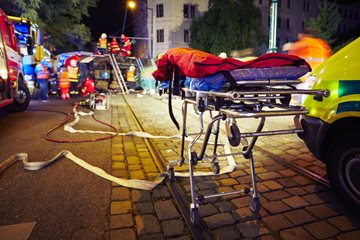 Every day, the team of Community Medical Centers is ready for a crisis. Our frontline emergency caregivers and support staff go through education, training, and drills to prepare for many types of catastrophic events: active shooters, earthquakes, floods, and everything in between.
Every day, the team of Community Medical Centers is ready for a crisis. Our frontline emergency caregivers and support staff go through education, training, and drills to prepare for many types of catastrophic events: active shooters, earthquakes, floods, and everything in between.
But the mass shooting at the Mandalay Bay in Las Vegas is just one of the recent mass casualty events that have made professionals in healthcare and law enforcement recognize the need to provide crisis training to the public.
Learning basic trauma skills may help you save a life while waiting for first responders to arrive. While we hope you never have to use this information, it’s important to be prepared for the unexpected and the most unthinkable events.
The Run – Hide – Fight Approach
Before offering your help, ensure your own safety. In the event of an active shooter, Community has adopted the Run – Hide – Fight approach, endorsed by the Department of Homeland Security.
Run
Have an escape route and plan
Leave your belongings behind
Evacuate quickly regardless of whether others agree to follow
Help others escape, if possible
Call 911 when you are safe
Hide
Hide in an area out of the shooters view
Lock the door or block entry to your hiding place
Silence all electronic devices
Fight
Fight only as a last resort and only when your life is in imminent danger
Act with as much physical aggression as possible
Use improvised weapons found where you are located
Commit to your actions…your life depends on it!
If you are in a safe place to help anyone who is injured, here are some quick tips to help locate and stop life-threatening bleeding.
Step 1: Create a clear view of the potential wound
Remove clothing from where you believe the wound is. This will help you clearly see any injuries that were hidden by the clothing to locate any life-threatening bleeding.
Step 2: Locate “life-threatening” wounds.
These are usually very obvious from the amount of blood being emitted from the wound. Signs of life-threatening bleeding include:
-
Spurting blood
-
A continuous flow of blood
-
Pooling blood on the ground
-
Loss of all or part of an arm or leg
Tip: A victim who is confused or unconscious likely has a life-threatening wound. Try to find it.
Step 3: Compress and Control
The number one thing that you need to do is compress a bleeding blood vessel to stop the bleeding.
-
Take any clean cloth (for example, a shirt) and cover the wound
-
If the wound is large and deep, try to “stuff” the cloth into the wound
-
Apply continuous pressure with both hands directly on top of the bleeding wound
-
Push down as hard as you can
-
Hold pressure to stop bleeding
-
Continue pressure until medical responders can replace you
Again, we hope that you never have to use this information, but these important tactics can keep you safe and help others during a shooting – or other medical emergency. Learning a few life-saving tips and techniques will allow you to provide immediate, frontline aid until first responders can take over.
Community Regional Medical Center’s Trauma Department provides elective hands-on Stop the Bleed training to all of our employees. While we aren’t currently offering any classes for the public, you can find a class and learn more by, visit www.BleedingControl.org for more information.
Lucky Malhi
VP of Materials Management
Community Medical Centers
VP Security Services
Community Regional Medical Centers


_123.jpg)
